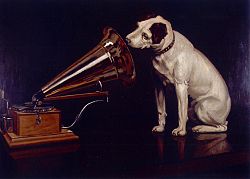It must have been 1938, possibly late August. While I was still alone in my studio, back on earth my grandfather (Harry) was home from a trip to the islands, or maybe by this time he had begun work in Gisborne on the dredge.
The house in Kohimarama had oak trees at the back on the southern side, where the boundary with the church land was. It made the property into one with a huge playground, and every summer I, He/Harry would put upp a swing on one of the oak branches. August was still a few months away from summer.
Harry would also put the wind up gramaphone on the bottom step of teh stairs leading up to the bedrooms, and play requests to the girls as they went off to sleep.
Upstairs, (in my home on plane pluto) I was only vaguely aware of what was happening, as I was busy on my own projects, but I could hear the music this night. Jess, who must have been almost 14 by then, could hear it too.
Harry knew there was a war coming in europe, anybody with any sense did, and he knew it was because of the harsh austerity measures being imposed on germany, which had forced its economy into ruin. Inflation was so high, people needed a wheelbarrow full of papaer money to pay for a loaf of bread.
The music coming out of the music horn told of a tragic story. It told of the German Invasion of Poland, the troops, the taking down of the frontier crossings, the war, and although this was not a matter for me, it was God telling the story, and I did not need to be included, I could hear it faintly. Soon, on September 1st, the whole world would hear the news. It was simply my wish that the women of the world would get the news in time to make the proper preparations, and to escape as quickly as they could.
His Master's Voice is a trademark in the music business, and for many years was the name of a large record label. The name was coined in 1899 as the title of a painting of the dog Nipper listening to a wind-up gramophone. In the photograph on which the painting was based, the dog was listening to a phonograph cylinder.
The trademark image comes from a painting by English artist Francis Barraud, A.R.A. and titled His Master's Voice. It was acquired from the artist in 1899 by the newly-formed Gramophone Company. According to contemporary Gramophone Company publicity material, the dog, a fox terrier called Nipper, had originally belonged to Barraud's brother Mark. When Mark Barraud died, Francis inherited Nipper, along with a cylinder phonograph and a number of recordings of Mark's voice. Francis noted the peculiar interest that the dog took in the recorded voice of his late master emanating from the trumpet, and conceived the idea of committing the scene to canvas.
In early 1899, Francis Barraud applied for copyright of the original painting using the descriptive working title Dog looking at and listening to a Phonograph. He was unable to sell the work to any cylinder phonograph company, but The Gramophone Company purchased it later that year, under the condition that Barraud modify it to show one of their disc machines. The image was first used on the company's publicity material in 1900, and additional copies were subsequently commissioned from the artist for various corporate purposes.[1]
Later, at the request of the gramophone's inventor Emile Berliner, the American rights to the picture became owned by the Victor Talking Machine Company. Victor used the image more aggressively than its UK partner, and from 1902 on all Victor records had a simplified drawing of the dog and gramophone from Barraud's painting on their label. Magazine advertisements urged record buyers to "Look for the dog".
The Invasion of Poland, also known as the September Campaign or 1939 Defensive War (Polish: Kampania wrześniowa or Wojna obronna 1939 roku) in Poland and the Poland Campaign (German: Polenfeldzug) in Germany, was an invasion of Poland by Germany, the Soviet Union, and a small Slovak contingent that marked the start of World War II in Europe. The invasion began on 1 September 1939, one week after the signing of the Molotov–Ribbentrop Pact, and ended on 6 October 1939 with Germany and the Soviet Union dividing and annexing the whole of Poland.
The morning after the Gleiwitz incident, German forces invaded Poland from the north, south, and west. As the Germans advanced, Polish forces withdrew from their forward bases of operation close to the Polish-German border to more established lines of defence to the east. After the mid-September Polish defeat in the Battle of the Bzura, the Germans gained an undisputed advantage. Polish forces then withdrew to the southeast where they prepared for a long defence of the Romanian Bridgehead and awaited expected support and relief from France and the United Kingdom.[14] The two countries had pacts with Poland and had declared war on Germany on 3 September, though in the end their aid to Poland in the September campaign was very limited.
In 1921, the Gramophone Company opened the first HMV shop in London, England;[7] the composer Sir Edward Elgar participated in the opening ceremonies.[8] In March 1931 the Gramophone Company merged with Columbia Graphophone Company to form Electric and Musical Industries Ltd (EMI).

